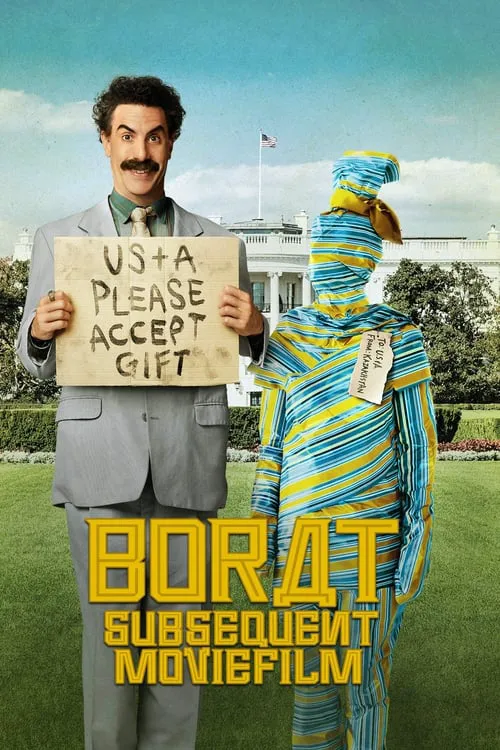Borat Subsequent Moviefilm

Plot
Borat Subsequent Moviefilm marks the return of Sacha Baron Cohen's infamous Kazakhstan correspondent, Borat Sagdiyev, in a sequel of sorts, 14 years after the events of the original Borat: Cultural Learnings of America for Make Benefit Glorious Nation of Kazakhstan. This time around, Borat finds himself in an unfamiliar yet intriguing role - that of a father to a young daughter named Tutan. As the COVID-19 pandemic sweeps across the globe, the would-be father-daughter duo embark on a perilous journey to the United States, with Borat's goal of obtaining a visa for Tutan to secure a slot for her at an elite boarding school. In typical 'Borat' fashion, this premise quickly evolves into a satirical commentary on societal norms, cultural behaviors, and the cacophony of American politics. From the moment Borat touches down in the States, the film unleashes a dizzying array of sketches, pranks, and interviews, ensuring no cultural stone remains unturned. In what's become a hallmark of his brand of humor, Borat expertly navigates societal minefields, usually oblivious to the increasingly fraught atmosphere surrounding him. Equipped with an endearing yet utterly bewildered expression, he weaves a narrative that frequently provokes gasps and cringe-worthy moments. As they navigate America, Borat and Tutan encounter a kaleidoscope of eccentric figures, ranging from gun-toting patriots to clueless social media personalities. Some encounters slip into the realm of farce, with Borat's 'strategic positions' or mock-pseudo-journalistic endeavors giving rise to amusing results. He even visits a liberal artist who promptly requests and is paid for an Instagramable selfie with Borat holding a severed sheep's head in a hollow, almost solemn ceremony. Borat Subsequent Moviefilm also tackles the COVID-19 pandemic from multiple perspectives, moving the narrative into areas where satire blends imperceptibly with documentation. An enlightening sequence shows the duo infiltrating a national convention of right-wing activists. Quickly, Borat picks up its characteristic anti-fascist rhetoric tone. Some conservative figures attempt to use his charm against him. Within scenes of levity, the protagonists hit upon acute societal connotations in areas where so-called socially 'progressive activists' exhibit 'infuriating moral complacency.' Despite the myriad comedic elements, Borat Subsequent Moviefilm undercuts its outrageous aspects with pointed social commentary and a keen insight into American society's fragile psychological underpinnings. Beneath Borat's clumsy layers and bizarre antics, lies a dark portrayal that strips down America's obsession with fear-mongering ideologies. There is ample room for observations encompassing reactions to mass shootings, Donald Trump's fanatics, COVID-19, and a host of sensitivities to cultural biases across American regions. Tutar, who becomes the central figure as the movie continues, serves as a perfect counterbalance to Borat's antics. A sharp-eyed teenager who reflects and occasionally corrects Borat's outlandish thinking, Tutar provides the subtle yet piercing remark that speaks volumes about her inner thoughts on the various events taking place in her life. We learn more about Borat's own past, focusing on his marriage to Oksana and his subsequent disconnection from his daughter due to his patriarchal social values. With their unconventional odyssey capturing America as we have never seen it in Borat Subsequent Moviefilm, a broad cultural reflection on society emerges, blurring the lines between irony and acridly sharp commentary. With his once provocative mask becoming more ambiguous, this unapologetic satirist takes the U.S.' uneasy dichotomy where stereotypes fall through lines created by authentic public truths. In a peculiar turn of events at the end of this wild, explosive US road trip, we see Borat in a familiar yet distinctly new role – that of a potential martyr for his country's higher ideals and less fortunate, oppressed people, becoming a model of perfect moral compromise.
Reviews
Recommendations

